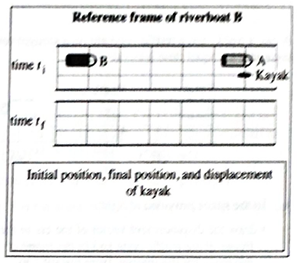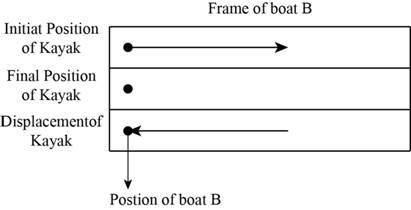
Concept explainers
Reference frame of boat B:
Complete the upper diagram at right by drawing and labeling boats A, B, and the kayak at their positions at time
In the space at lower right, draw and label vectors for the initial position, the final position, and the displacement of the kayak in the frame of boat B.
In the frame of boat B, is the speed of the kayak greater than, less than, or equal to the speed of boat A? Explain.

The position of boat A, B and kayak at time
Explanation of Solution
Introduction:
A frame of reference is a combination of coordinate
In frame of boat B, the speed of boat B is zero. Boat A and kayak will move in the left direction in frame of boat B.
The final position of boat A, boat B and in frame of boat B is shown in figure 1.

Figure 1
The initial position, final position and displacement of kayak are shown in figure 2.

Figure 2
The displacement of kayak is more than the displacement of boat A for same interval of time. So, the speed of kayak is greater than the speed of boat A in frame of boat B.
Conclusion:
Therefore, the position of boat A, B and kayak at time
Want to see more full solutions like this?
Chapter 15 Solutions
Tutorials in Introductory Physics
Additional Science Textbook Solutions
Cosmic Perspective Fundamentals
College Physics: A Strategic Approach (4th Edition)
Introduction to Electrodynamics
University Physics Volume 2
College Physics (10th Edition)
- The DETECTOR IS AT THE ORIGIN (position of 0). Choose the statements that accurately describe the motion of the car f GRAPH T At the end the cart is moving with constant speed. 10:At the end the cart is at rest. U Initially the cart moves away from the detector. As the cart is moving, its speed increases. position O Initially the cart moves toward the detector. As the cart is moving, its speed decreases.arrow_forwardA. From the perspective of point x, vector a and vector b are approaching with around the same speed. From Joseph's perspective, the two are walking with around the same speed. Determine if vector a is approaching with the same speed, twice the speed, or half the speed from the perspective of vector b. Explain.B. Vectors x and y are moving with uniform velocities. If the image below is t = 0, how long will it take (in seconds) for vector x to be in the same position with vector y? How far should vector x have traveled (in meters) by the time it has overtaken the position of vector y? Show proper solution.arrow_forwardThe diagram below is comprised of four vectors A, B. C and D. Using addition and subtraction of vectors, describe the following: D A B Note: your answer should be an algebraic expression comprising of A, B. C and D. Make sure to take note of the positions of the tails and heads of each vector. B = 0 = |(i.e., when you add the vectors together, they cancel and equal 0)arrow_forward
- A frog jumps at an angle 30° above the horizontal. The origin of the coordinate system is at the point where the frog leaves the ground. Complete the attached table by drawing check marks in the cells that correctly connect the quantities in the first column that describe the motion of the frog and the descriptions of what is happening to these quantities while the frog is moving. For each quantity, explain why your choice is correct. Consider the frog as a point-like object and assume that the resistive force exerted by the air is negligible.arrow_forwardUse the following information to answer parts a and b. A motorboat is travelling at its maximum speed of 6.0 m s⁻¹ straight across a river, which has a current of 3.8 m s⁻¹ downstream, as shown in the diagram The banks of the river are parallel to each other and straight. a) Calculate the velocity of the boat as seen by someone at the position marked ‘A’ on the diagram. b) If the river is 1100m wide, how long does it take for the boat to reach the other bank?arrow_forwardA car drives around an eliptical race track as pictured at right. It starts at rest near the bottom of the diagram and speeds up to its maximum speed between points A and B, after which it conintues at a constant speed. Draw acceleration vectors at points A, B, and C to represent the direction of the acceleration of the car at these 3 points. Explain your answer. Is the magnitude of the acceleration at point B larger, smaller, or equal to the magnitude of the acceleration at point C? Explain your answer.arrow_forward
- Two carts are riding on an air track as shown in the figure at the right. At clock time t = 0 cart B is at the origin traveling in the +x direction with a velocity speed VB0. At that time, cart. is at the position shown and is at rest. Cart B has twice the mass of cart A. The carts "bump" each other, but don't stick. Before initially at rest 10° cart A cart B In the graphs below are shown a number of possible plots for the various physical parameters associated with the two carts. Each graph has two curves, one for each cart and labeled with the cart's letter. For each property (a)-(e) select the letter of the graph that could be a plot of the property. a. The forces exerted by the carts b. The position of the carts c. The velocity of the carts d. The acceleration of the carts e. The momentum of the carts. 1.6 10 2 A A A 0.0 5 B B B 0.0 ° ° -0.8 #1 -1.6 ° 2 1 ° #4 1.6 B 0.8 A 100 time -5 #2 -1 #3 10 100 tine D 0 B -1 100 tine 10 D A 0.0 ° -0.0 #7 -1.6 10 100 tine O #5 5 B 100 tine B A…arrow_forwardTwo students, student 1 and student 2, are discussing the graph shown above, which shows the vertical component of the velocity of the box from when it leaves the ramp to immediately before it hits the floor. The students make the following statements. Student 1: This graph shows that the vertical acceleration of the box is constant, and that the box’s speed decreases for the entire time shown. Student 2: The area between the graph and the time axis is the box’s vertical displacement, but the graph is incorrect because the positive displacement should be equal to the negative displacement. (e) Which underlined phrase or phrases in student 2’s statement are correct, if either? If neither phrase is correct, write “none.”arrow_forwardTwo students, student 1 and student 2, are discussing the graph shown above, which shows the vertical component of the velocity of the box from when it leaves the ramp to immediately before it hits the floor. The students make the following statements. Student 1: This graph shows that the vertical acceleration of the box is constant, and that the box’s speed decreases for the entire time shown. Student 2: The area between the graph and the time axis is the box’s vertical displacement, but the graph is incorrect because the positive displacement should be equal to the negative displacement. (c) Which underlined phrase or phrases in student 1’s statement are correct, if either? If neither phrase is correct, write “none.” (d) Which underlined phrase or phrases in student 1’s statement are incorrect, if either? If neither phrase is incorrect, write “none.” (e) Which underlined phrase or phrases in student 2’s statement are correct, if either? If neither phrase is correct, write “none.” (f)…arrow_forward
- Two students, student 1 and student 2, are discussing the graph shown above, which shows the vertical component of the velocity of the box from when it leaves the ramp to immediately before it hits the floor. The students make the following statements. Student 1: This graph shows that the vertical acceleration of the box is constant, and that the box’s speed decreases for the entire time shown. Student 2: The area between the graph and the time axis is the box’s vertical displacement, but the graph is incorrect because the positive displacement should be equal to the negative displacement. The angle of the ramp is changed such that it is larger than θ but less than 90 degrees, while the height of the end of the ramp remains the same. (h) How would the maximum height of the box compare to the original scenario in which the ramp angle was equal to θ ? Justify your ansarrow_forwardTwo students, student 1 and student 2, are discussing the graph shown above, which shows the vertical component of the velocity of the box from when it leaves the ramp to immediately before it hits the floor. The students make the following statements. Student 1: This graph shows that the vertical acceleration of the box is constant, and that the box’s speed decreases for the entire time shown. Student 2: The area between the graph and the time axis is the box’s vertical displacement, but the graph is incorrect because the positive displacement should be equal to the negative displacement. (f) Which underlined phrase or phrases in student 2’s statement are incorrect, if either? If neither phrase is incorrect, write “none.”arrow_forwardTwo students, student 1 and student 2, are discussing the graph shown above, which shows the vertical component of the velocity of the box from when it leaves the ramp to immediately before it hits the floor. The students make the following statements. Student 1: This graph shows that the vertical acceleration of the box is constant, and that the box’s speed decreases for the entire time shown. Student 2: The area between the graph and the time axis is the box’s vertical displacement, but the graph is incorrect because the positive displacement should be equal to the negative displacement. (i) Would the slope of the graph of vertical velocity as a function of time shown above part (c) be different for this scenario in which the box is launched from the larger angle? Justify your response.arrow_forward
 College PhysicsPhysicsISBN:9781305952300Author:Raymond A. Serway, Chris VuillePublisher:Cengage Learning
College PhysicsPhysicsISBN:9781305952300Author:Raymond A. Serway, Chris VuillePublisher:Cengage Learning University Physics (14th Edition)PhysicsISBN:9780133969290Author:Hugh D. Young, Roger A. FreedmanPublisher:PEARSON
University Physics (14th Edition)PhysicsISBN:9780133969290Author:Hugh D. Young, Roger A. FreedmanPublisher:PEARSON Introduction To Quantum MechanicsPhysicsISBN:9781107189638Author:Griffiths, David J., Schroeter, Darrell F.Publisher:Cambridge University Press
Introduction To Quantum MechanicsPhysicsISBN:9781107189638Author:Griffiths, David J., Schroeter, Darrell F.Publisher:Cambridge University Press Physics for Scientists and EngineersPhysicsISBN:9781337553278Author:Raymond A. Serway, John W. JewettPublisher:Cengage Learning
Physics for Scientists and EngineersPhysicsISBN:9781337553278Author:Raymond A. Serway, John W. JewettPublisher:Cengage Learning Lecture- Tutorials for Introductory AstronomyPhysicsISBN:9780321820464Author:Edward E. Prather, Tim P. Slater, Jeff P. Adams, Gina BrissendenPublisher:Addison-Wesley
Lecture- Tutorials for Introductory AstronomyPhysicsISBN:9780321820464Author:Edward E. Prather, Tim P. Slater, Jeff P. Adams, Gina BrissendenPublisher:Addison-Wesley College Physics: A Strategic Approach (4th Editio...PhysicsISBN:9780134609034Author:Randall D. Knight (Professor Emeritus), Brian Jones, Stuart FieldPublisher:PEARSON
College Physics: A Strategic Approach (4th Editio...PhysicsISBN:9780134609034Author:Randall D. Knight (Professor Emeritus), Brian Jones, Stuart FieldPublisher:PEARSON





